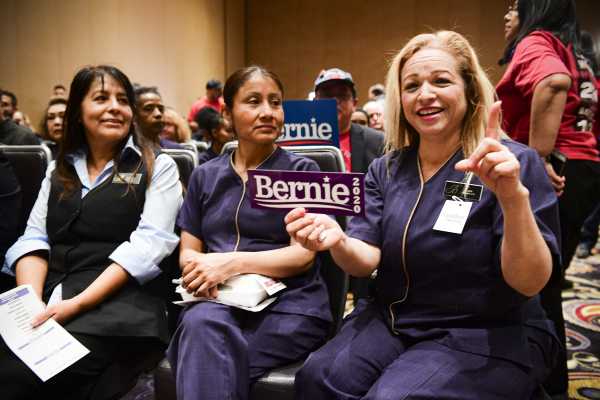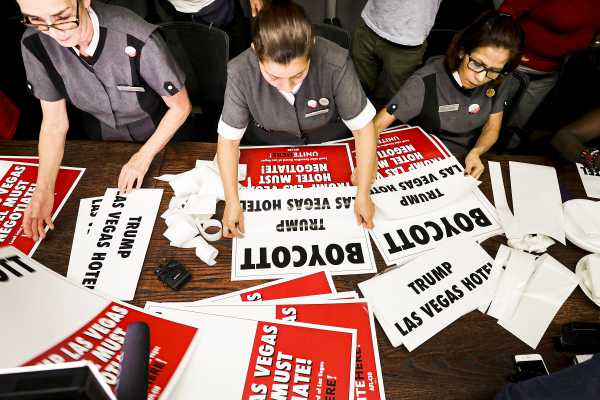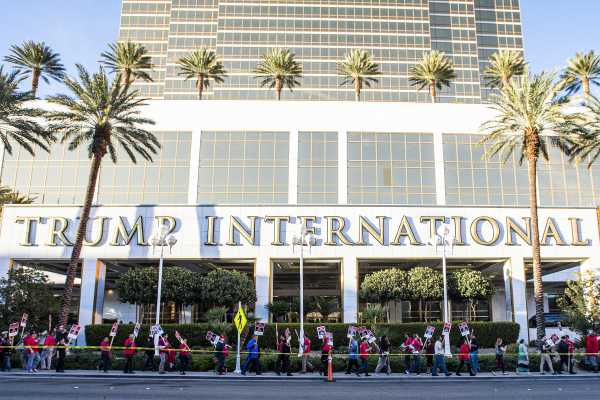 />
/>
Share this story
-
Share this on Facebook
-
Share this on Twitter
-
Share
All sharing options
Share
All sharing options for:
Culinary Union members seem to have broken from their leaders to back Sanders
-
Reddit
-
Pocket
-
Flipboard
-
Email
Early reports suggest a surprising upset of sorts in the Nevada caucuses — Culinary Union members broke from their leadership and caucused in wide numbers for Sen. Bernie Sanders, according to longtime Nevada journalist Jon Ralston.
In recent weeks, Sanders — running as a champion of labor — has been dealing with a scandal involving the Nevada Culinary Workers Union Local 226 and Bartenders Union Local 165. Union leaders released an informational flyer critical of his Medicare-for-all plan that stated Sanders wanted to take away Culinary Union members’ health care. Union leaders faced very public harassment from some claiming to be Sanders supporters.
Yet as caucus returns began to trickle in on Saturday, it appears the conflict wasn’t really between Sanders and union workers, but with leaders.
The scandal heated up in the runup to Nevada because the union can mobilize its 60,000 members, using them to ensure Democratic candidates win at the local, state, and federal levels. Early data seems to show that, in the end, Sanders was the beneficiary of those votes.
A flyer on health care dropped the Culinary Union into the middle of a nasty debate
In the wake of the New Hampshire primary, the Culinary Union drew national attention for a leaflet it produced comparing the leading candidates’ health care proposals. The flyer identified Sanders as the candidate who would “end Culinary Healthcare” given his support for Medicare-for-all, a summary some Sanders supporters felt was more an attack and less a précis of policy.
The flyer quickly became a source of controversy and led to a series of racist, sexist, political, and professional attacks against both Culinary Union’s Secretary-Treasurer Geoconda Argüello-Kline and union spokesperson Bethany Khan.
“Two minority women, women of color, and they don’t say one word to the president who is a white man,” Argüello-Kline said. “And I feel happy they don’t touch him, they don’t say anything to him, but I see difference in how we’ve been treated, and that’s been Bernie Sanders supporters.”
A number of these attacks do appear to have come from those expressing support for Sanders, but as Zeeshan Aleem has explained for Vox, the provenance of these attacks isn’t clear in every case, with at least some coming from conservatives opposed to Medicare-for-all.
They nevertheless led to a condemnation from Sanders, who said in a statement, “Harassment of all forms is unacceptable to me, and we urge supporters of all campaigns not to engage in bullying or ugly personal attacks,” as well as critiques from other candidates.
Argüello-Kline told Vox the flyer was not meant to be an attack on Sanders, but a brief, comprehensive summary of the candidates’ various stances on health care — an issue of great import to Culinary Union members, who have won through hard-fought negotiations what the secretary-treasurer said is “the best health care in Nevada.”
Related
Nevada Democratic caucuses: Live results
“The intent was to repeat what Sen. Sanders said,” Argüello-Kline said. “We did not change what he said. He’s been saying that on TV. He’s been saying that in every commercial that he has. He’s been saying that on the radio. He’s been saying that in the newspaper. He even said it in the [Culinary Union’s] town hall. … The only thing we did is put in writing what he says.”
The union health plan covers more than 130,000 people statewide and actually functions in a manner similar to how insurance would work under Sanders’s Medicare-for-all proposal: You go to your doctors and you don’t have to worry about out-of-pocket costs.
“For example, [with commercially available] health insurance, I need to pay for me, for my daughter, very expensive, every month,” union member Mirtha Rojas told PBS NewsHour. “In the union, [I] don’t pay nothing.”
It’s the strength of this plan that makes the union against Medicare-for-all, according to Argüello-Kline, who said, “Give the government health care to people [who] don’t have [any]. But why do you have to give up something you already have?”
“We want the best health care for every human being,” she added, suggesting the government adopt a model like Australia’s. “In some countries you have the government health care and the private health care. And that’s what we’re looking for.”

But according to MSNBC’s Chris Jansing, some union members said Saturday that they are concerned about being able to meet their health care needs should they lose their jobs — and that Medicare-for-all would ensure they would still have insurance should that happen.
Rebecca Gill of the University of Nevada Las Vegas told Vox that union leaders are likely concerned about what the union itself might stand to lose should Medicare-for-all somehow become a reality.
“Part of the power the union has — well, the key power — is negotiating these contracts,” Gill said. “And really, the medical plans, this is one of the main areas of negotiation that they have. So it is a source of power, their ability to encourage membership by providing this relatively better plan than most Americans get. So I think from the perspective of the union, it’s essentially taking a tool out of their toolbox.”
As with any organization that relies on collective action, a large part of the union’s influence stems from its numbers; a reduction in size would dilute its power. This incident with the flyer, is, however, a good reminder of just how much influence the union wields and to what extent those outside Nevada understand that influence.
Although some of those lobbing hate were just trolls, and although there is no excuse for any candidate’s supporters being cruel, the response is a testament to the fear these supporters had that this flyer would derail their candidate — a fear that ultimately seems to have been unfounded.
Conversely, an endorsement from the union was widely seen as something that would provide the recipient with great momentum headed into the caucuses — and was something openly coveted by candidates in need of an eleventh-hour boost like former Vice President Joe Biden.
What happened with the endorsement this time
The union called a press conference to announce its endorsement last Thursday, and as Vox’s Dylan Scott reported, Argüello-Kline surprised observers by declaring, “We’re going to endorse our goals. … We’re not going to endorse a candidate.”
“An endorsement would be controversial. … Looking from the outside, I’m not surprised they decided not to endorse, because this allows their members to vote their conscience,” Gill said, adding, “Creating some sort of conflict at the caucus stage might be counterproductive for those efforts to get out the vote in November.”
And indeed, Argüello-Kline said the union really has only one goal: “We want to elect a presidential candidate from the Democratic Party and defeat President Trump — that’s our mission right now.”
The union has made it clear its preference is a candidate who does not back Sanders’s Medicare-for-all legislation as it is currently written, but it has increasingly pivoted away from trying to guide the primary process through direct endorsements and toward wielding its influence through educational material instead.
In part, this may be because its last caucuses endorsement did not go well — its 2008 endorsement of Barack Obama divided its members and led to ugliness and resentment throughout the process.

Hillary Clinton’s campaign was not pleased with the decision, Clinton supporters in other unions launched lawsuits, and an angry Bill Clinton lashed out at the press and was accused by some of trying to unfairly pressure union members at caucus sites.
And after all this, the union’s candidate didn’t actually “win.” Clinton received more votes, although Obama came away with more delegates — 13 to her 12. And many union members were vocal about their frustration with the entire endorsement process. Member Steve Gelt told the New York Times that union leaders were “bullying and threatening us to vote for Obama.”
This sort of dissatisfaction led the union to abstain from the 2016 caucuses, despite both Clinton and Sanders lobbying for its backing. It did endorse Clinton in the November contest in what appears to have become the new model for the union — one it showed signs of perfecting in 2018.
A brief history of the Culinary Union
An affiliate of Unite Here — a union with more than 300,000 members across the country — the Culinary Union is Nevada’s largest and reflects the state’s diversity; more than half of its members are women, and more than half are Latinx.
Throughout its history, the union has served as a platform to eke out benefits for workers in the state’s entertainment industry and is perhaps best known for supporting — along with four other unions — the US’s longest continuous labor action: a 24/7, nearly 6.5-year strike demanding the Frontier Hotel come to the negotiating table over wages and benefits. The hotel eventually closed and was replaced in part by a Trump hotel, which in 2015 faced a similar strike over its management’s refusal to acknowledge its workers’ union — a strike that led to the Trump organization acquiescing to members’ requests during his first campaign for president.


Those sorts of wins are par for the course for the union, which, over more than 80 years, has become an established part of the community, offering free job training, its own health care services, assistance with becoming a US citizen, and serving as an important springboard for Democrats running for office.
As University of Nevada Las Vegas professor David Damore told Messerly in 2016, “They’re not going to be able to go dollar for dollar against the Koch brothers, but Culinary is the best ‘get out the vote’ in town.”
For a test of the union’s power, look no further than the 2018 midterm election cycle. The union registered 10,000 people to vote and spent months canvassing; it claims to have knocked on nearly 400,000 doors in the state. Its efforts also included a digital, video, and radio advertising campaign as well as massive direct-to-voter outreach featuring 1.7 million pieces of US mail, more than half a million phone calls, and tens of thousands of emails and texts.
The effort — all of it in service of the race’s Democratic candidates — paid off, with the Democratic Party winning back a US Senate seat, successfully defending two US House seats, and expanding its hold on the state legislature (while also becoming the first state in US history to have the majority of its lawmakers be women). The election also brought the state its first Democratic governor in 20 years, Steve Sisolak.
In his acceptance speech, Sisolak promised to support those union workers who helped deliver his victory, leading them in chanting, “Union, union!”
The secret to this success, Argüello-Kline said, is that the union is incredibly organized, disciplined in its messaging, and able to drive not just its 60,000 members to the polls, but their families and friends as well: “We organize everybody in the family,” she said.
“Our role is to be sure the members, they vote, and they understand how important it is to vote,” Argüello-Kline added. “We work really hard all the time making phone banks. We have 1,000 rank-and-file leaders inside the hotels, and we have internal organizers talking to them, how important it is to show up to vote.”
What the union does if it doesn’t endorse
The union now sees its role as an educator and a conduit to drive high voter participation. The educational piece is done through flyers, like the one on health care that became such a source of controversy, but also through candidate town halls and the aforementioned direct-to-voter efforts.
In order to encourage high attendance, the union has worked to expand poll access, pushing for caucusing sites at its members’ workplaces — including a 24-hour early caucus site at the Bellagio hotel — and made its union hall an early caucus site as well.
“We’ve been working intensely to bring them to the caucus sites where they can vote early,” Argüello-Kline said. “And that has been successful.”

On Wednesday, the last day for early caucusing, Argüello-Kline said union leaders arrived to open the hall and found 1,500 people waiting to fill out their early caucuses forms. Ralston, founder of the Nevada Independent, reported the early voting totals have nearly matched the total caucuses turnout in 2016, with roughly 70,000 people having now already caucused (around 84,000 caucused in 2016, when there was no early caucusing).
Maintaining that level of enthusiasm — and directing it behind the Democratic ballot, including the eventual nominee — in November is top of mind for union leaders, who signaled ahead of the results favoring Sanders that they would mobilize behind whoever the eventual nominee is.
“This year is a very important year,” Argüello-Kline said. “I think the people is the power of the union, and we communicate with the workers all the time. And they understand why they have to be active.”
Sourse: vox.com






